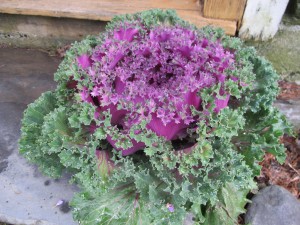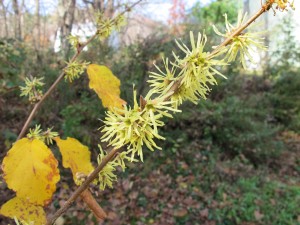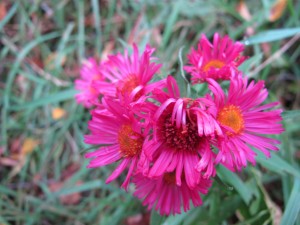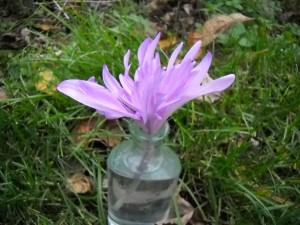Plants for the Front Porch
We New Englanders have a long tradition of doing something to brighten the approach to our front door. In winter it’s a nice green wreath; my grandmother liked red geraniums in a pot by the door all summer; in fall, pumpkins and chrysanthemums are traditional decorations. Three common decorative plants are available for purchase at farm stands now – and worth a look.
Chrysanthemums are very popular, and are readily available in a wide range of colors. I treat them as annuals even though some are touted as perennials. I once estimated the number of buds and blossoms on a potted “mum”. By counting and multiplying I arrived at an estimate of 300 blossoms on a plant that was perhaps 18-inches across. Phenomenal. But if I had planted it in the ground and it came back the next spring, I would have gotten just a small fraction of the number of blossoms the following year. Why? The growers pinch back the stems at least twice to make the plant branch again and again. I don’t have the patience to do so.
A few tips about keeping mums happy. First, they have a large number of blossoms and leaves for the size of their pots. On a crisp fall day a mum loses a lot of water, especially on a sunny doorstep. You probably should water daily, or every other day. If yours comes in a peat pot, which many do, the soil or potting mix will dry out even faster than if it’s growing in a plastic pot. I find that submerging the pots in a big container of water and holding them down until they stop bubbling is the best way to get the roots full hydrated. Or transplant them to self-water containers that have water reservoirs to prevent roots from drying out.
Secondly, if you want to plant your mums in the ground, be careful at planting time: the branches are often very brittle. It’s always disappointing to me when I break off a big section of a mum before it can even strut its stuff for a moment. Usually I just leave my mums in their pots and arrange them by the front door.
If I do plant my mums, I endeavor to plant them deep enough so that I can cover the root ball with an inch of real soil (they are planted in a peat-based growing mix that dries out very quickly). And although you can plant the peat pots directly in the ground, tear off the top 2 inches of pot so that it won’t be sticking up and wicking water away. Remember, a dry mum is an unhappy mum. Frost seems a long way away now, but remember to cover mums when hard frost comes, or bring the pots indoors. They survive light frost nicely.
Another great fall doorstep plant is decorative cabbage or kale. I just bought a big fat one at a farmers market recently, and it will look great all fall, assuming I don’t let it dry out. Last year I started a couple of dozen decorative kales from seed, but was disappointed that they stayed smaller than those generally sold, and bolted in the heat of summer. Huh. The professionals seem to have tricks I do not. I had mine in the ground, not pots, and had planned on transplanting them into nice containers after Labor Day, but ultimately I didn’t think them worthy of moving to the front of the house.
Decorative kale generally has dark green or purplish leaves on the outside, and pink, white or light purple inside. I’ve read that they are, indeed, edible, but are tough and leathery; why bother when edible kale is so easy to grow and tasty? Another great feature of decorative kale is its ability to survive frost. It will not even blink when temperatures drop down into the teens, assuming that your plant has seen temperatures in the twenties and has had time to get used to cold weather. I’ve read that they will survive temperatures as low as 5 degrees without harm.
The last of the fall porch plants are the short asters commonly available in blues and purples, and occasionally in white. Like the mums, these have been pinched back to stimulate the production of more blossoms – and to keep them short. Most are winter hardy, and I have planted them in the ground and let them come back for a second show the next year. But instead of being under a foot tall, they were at least 18 inches tall and only had a few blossoms. I never got around to pinching them back. Nice in the second year, but not dramatic. I usually prefer to buy new plants and let someone else do all the hard work.
Even if you have some new mums on the porch, don’t forget about your window boxes and planters full of annuals. Yes, they may look bedraggled now, but with a little care you can give them new life. Deadhead blossoms, cutting back stems several inches below those tired seed heads. This is tedious, but worthwhile. And give those annuals a burst of energy with some liquid fertilizer. I use a liquid fish mix, but there are plenty of choices, and almost anything will help.
When I see a nice pot of flowers on a neighbor’s porch I always think, “How nice. She is blessing us all with a glimpse of beauty as we go by.” I try to do my part in doing the same, and hope you will, too.
Henry Homeyer is a gardening coach, garden designer and the author of 4 gardening books. His Web site is www.Gardening-guy.com.
What’s Blooming Now in the Garden
By mid to late October, many gardens are looking quite drab. That need not be the case, and this week I’d like to mention a few of the flowering plants that are cheering up my gardens now.
Witch hazel (Hamamelis virginiana) is a native shrub that grows in the understory and blooms now (or in the early spring, for Hamamelis x intermedia). The flowers are not dramatic on most varieties– they are less than in inch in diameter, and are arranged close to the stem. Although I’ve seen witch hazel in a public garden that had red blossoms, the native species that I grow is a pure yellow and the petals are very frilly – you could say “spider-like”. The look best after leaf drop.
As a kid I went to a barber who used a witch hazel tonic as an astringent after shaving men. To make us kids feel more grown up, perhaps, he applied some on the back of our necks when he was done with us. It is a very fresh scent that is made from the bark of young stems and roots of the shrub. The leaves, when crushed, also have a nice smell.
My Seven-Sons Flower Tree (Heptacodium miconioides) is still blooming now. This is a smallish tree (under 30 feet tall), but one that grows extraordinarily fast. It is not unusual for new stems to grow 3 to 5 feet in a season. I love the bark, which is exfoliating (shaggy). Its flowers are small and white, and appear in panicles (clustsers).
I am experimenting with mine to see how it does as a pollarded tree. Pollarding is a process of cutting off most new branches back to major branches every few years, keeping the size in check and crating large knobs where new growth originates. It’s a very popular pruning technique in Europe. Last year I cut off all the smaller branches, leaving a trunk and three major branches. This year I got dense clusters of branches growing from the ends of those major branches. Interestingly enough, many of the new stems are growing out and down, almost like a weeping tree.
Chrysanthemums great fall flowers that I buy in pots each year around Labor Day. I treat mums as annuals, even though some varieties will overwinter. Why? Because to get a dense, compact plant, one must pinch back the growing stems two or more times during the summer, and I have too much going on to remember to do so most years. There are people who do this for a living, and I am happy to let them do it. I like mums in window boxes (the smaller ones) and the big, dramatic ones in pots on my front steps. When they come in peat or cardboard pots I transplant them into plastic pots as the former dry out too quickly.
Fall asters have been splendid this year, both those that I planted and those growing along the roadside or edges of fields. The wild ones are mostly blues and purples. I purchased a pink aster that is in bloom right now, a variety called ‘Alma Plotschke’. She is an intense, deep rose pink and not nearly as tall as the wild ones.
Some smaller wild asters(12 to 24 inches tall are blooming at the edge of my lawn. My reference text on native flowers (The Illustrated Book of Wildflowers and Shrubs by William Carey Grimm) lists 29 species of wild asters. These short ones have bluish-white blossoms. I believe mine are the common blue wood aster (Aster cordifolius), which is usually a light blue or lavender. The differences between wild asters can be minute and there is much variety within a species, so they could be the white wood aster (Aster divaricatus), which is also common in New England. It doesn’t matter, they’re all lovely.
Fall crocus are wonderful! True fall crocus (Crocus sativus) are not fully hardy in my cold Zone 4 garden. Various vendors list them as hardy to Zone 4 or 5 or 6. I have had them winter over, and have a client nearby who has had them blooming each fall for years – in a Zone 4 garden. These crocus are the source of saffron, but I’ve read that it takes 10,000 flowers to make an ounce of saffron!
Colchicums are also called fall crocus, but are not true crocus. They look like crocus on steroids – they are commonly 6 inches tall! I planted a lot 10 years ago, but each year I have a few less. Unfortunately their stems do not usually support the flowers, so they flop. To avoid this I have planted them in amongst a ground cover like myrtle (Vinca minor) that helps to hold them up. Mine are mainly pink, but also have a few white, both as singles and doubles.
Some annual flowers hold up against frost for awhile, too. My favorite right now is Brazilian verbena (Verbena bonariensis), which is hardy down into the 20’. It grows three feet tall on thin, stiff stems with little clusters of purple-blue flowers. The flowers seem to float above shorter things. Look for it next summer.
Fall flowers are a gift. Even when I’m thinking about woodpiles and snow shovels, a few hardy plants keep on bringing me joy.
Henry is the author of 4 gardening books and a children’s book about a boy and a cougar. His Web sites are www.Gardening-guy.com and www.henryhomeyer.com.






